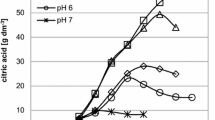Abstract
The yield of oxalic acid bySclerotium rolfsii was highest at 25 °C for the wild and X1 strains and at 30 °C for the X2 strain. The optimum pH for oxalic acid synthesis by wild X1 and X2 strains was 5.0, 6.0 and 4.5, respectively.
Similar content being viewed by others
References
Abeygunawardena D.V.W., Wood R. K. S.: Factors affecting the germination of sclerotia and mycelial growth ofSclerotium rolfsu Sacc.Trans.Brit Mycol.Soc. 40, 221 (1957).
Bateman D. F., Beer S. V.: Simultaneous production and synergistic action of oxalic acid and polygalacturonase during pathogenesis bySclerotium rolfsu.Phytopathology 55, 204 (1965).
Chakrabarti K., Samajpati N.: Effect of X-rays on the production of oxalic acid bySclerotium rolfsii.Indian J.Mycol.Res. 9, 33 (1971).
Chakbababti K., Samajpati N.: Effect of carbon sources on the growth and yield of oxalic acid bySclerotium rolfsu.Indian J Mycol.Res 16, 83 (1978)
Chakrababti K., Samajpati N.: Effect of nitrogen sources on the yield of oxalic acid bySclerotium rolfsii.Folia Microbiol. 25, 498 (1980).
Chowdhury S.: Effect of hydrogen-ion concentration on the growth and parasitism ofSclerotium rolfsii Sacc.Indian J.Agric Sci. 16, 293 (1946).
Emiliani E., Bekes P.: Enzymatic oxalate decarboxylation inAspergillus niger.Arch.Biochem. 105, 488 (1964).
Gondo M.: Soil ecological studied on the soil pathogens. 4. Effect of various soil factors on the growth onCorticium rolfsn curzi.Bull.Fac.Agric. 10, 23 (1962)
Grover R.K., Chona B. L.: Comparative studies onSclerotium rolfsu Sacc. andOzonium texanum Neal and Wester var.parasiticum thirmalachar. Indian Phytopaihol. 13, 118 (1960).
Higgins B.B.: Physiology and parasitism ofSclerotium rolfsu Sacc.Phytopathology 17, 417 (1927)
Kodanda Pany V., Apparao A.: Studies on the nutritional physiology ofSclerotium rolfsii Sacc.Proc Indian Acad.Sci., Sect B.57, 326 (1963).
Maxwell D.P., Bateman D.F.: Influence of carbon source and pH on oxalate accumulation in culture filtrates ofSclerotium rolfsu.Phytopathology 58, 1351 (1968a)
Maxwell D.P., Bateman D.F.: Oxalic acid biosynthesis bySclerotium rolfsii.Phytopathology 58, 1635 (1968b).
Misra A.P., Haque S.Q.: Factors affecting the growth and sclerotial production inSclerotium. rolfsii Sacc. causing storage rot of potato.Proc Indian Acad.Sci., Sect B56, 157 (1972).
Takao S.: Organic acid production by basidiomycetes. I. Screening of acid producing strainsAppl.Microbiol 13, 732 (1965).
Author information
Authors and Affiliations
Rights and permissions
About this article
Cite this article
Chakrabarti, K., Samajpati, N. Effect of temperature and pH on the yield of oxalic acid bySclerotium rolfsii . Folia Microbiol 28, 502–504 (1983). https://doi.org/10.1007/BF02879690
Received:
Issue Date:
DOI: https://doi.org/10.1007/BF02879690




